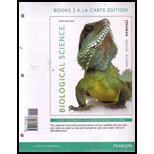
Concept explainers
Introduction:
Amino acids are the primary units of a protein. In total of 21 types of these organic compounds. Each amino acid has its own properties. Amino acids are largely grouped as essential and non-essential. The essential amino acids are ones which are not synthesized by the body and are essential to intake in the diet as they play important roles in the body, while the non-essential ones are made by the body.
Answer to Problem 1TYK
Correct answer:
All amino acids contain a carboxylic and an amino group.
Explanation of Solution
Justification/ Explanation for the correct answer:
Option (d) is given that every amino acid consists of a carboxylic and an amino group. The amino acids string in a polypeptide by forming a peptide bond sandwiched in the NH2 of one amino acid and the carboxylic group of the other. The
Explanation for the incorrect answer:
Option (a) is given that an amino acid has a carboxyl and a carbonyl group. This is a wrong statement as amino acid does not have a carbonyl group. It has an alkyl group, which is different for different amino acids. This alkyl group could contain a carbonyl bond, but it is not true for every amino acid. So, it is an incorrect option.
Option (b) is given that every amino acid has a carbonyl group and an N-H group. This is a wrong statement as every amino acid has an NH3+ group and carboxyl group (COOH) when present single. After bonding, with another amino acid, one hydrogen molecule of the NH3+ group and OH group of the COOH group forms a water molecule. A bonded amino acid has NH2 group a carbonyl group. So, it is an incorrect option.
Option (c) is given that each amino acid has a hydroxyl group and an amino group. This is a wrong statement as every amino acid has a carboxyl group and an amino group. The other bond is with an atom of hydrogen and an alkyl group. The alkyl group may contain a hydroxyl group (OH), but it is not true for every amino acid. So, it is an incorrect option.
Hence, options (a), (b), and (c) are incorrect.
Thus, it can be concluded that each amino acid has a carboxyl group and an amino group along with a hydrogen atom. The fourth bond is with an alkyl group, which is different for every amino acid.
Want to see more full solutions like this?
- Construct a Venn diagram using the one-letter symbol of the amino acids. Provide a reason that indicates why the amino acids are groups according to the venn diagram.arrow_forwardHow many amino acids and peptide bonds does a tetrapeptide have? A) four amino acids and three peptide bonds B) four amino acids and four peptide bonds C) three amino acids and four peptide bonds D) four amino acids and two peptide bondsarrow_forwardWhich functional groups are present in digitoxin? a. To what lipid family does the complex ring drawn to the right of the structure belong? b. Identify the type of glycosidic bond that joins each of the monosaccharide residue in the molecule c. Draw the open form of the monosaccharide used to produce the trisaccharide portion of digitoxin.arrow_forward
- Between which two amino acids do disulfide bonds form? A.Alanine-Glycine B.Serine-Threonine C.Cysteine-cysteine D.Methionine-methioninearrow_forwardWrite an essay on the structure and properties of the amino acid L-histidine . (200 Words)arrow_forwardIn one to ten words answer questions (1) – (8) below. In short phrases answer questions (9) and (10)  (1) What do the two structures above illustrate? (2) How many amino acids are represented in each structure? (3) How many glycine residues are represented in each structure? (4) How many proline residues are represented in each structure? (5) How many carbonyl groups are represented in each structure? (6) How many α carbons are there in each structure? (7) How many non-H, R side chains are represented in each structure? (8) How many peptide bonds are represented in each structure? (9) What does the red dotted line represent? (10) What is the main difference between the two structures?arrow_forward
- identify an amino acid that contains a side chain that can form hydrogen bonds with water (complete name)arrow_forwardName and draw the structures of the amino acids that fit the following descriptions:(a) Contains an isopropyl group(b) Contains a secondary alcohol grouparrow_forwardThe pI for the amino acid in the diagram is? A. 2.3 B. 5.9 C. 10.8 D. 9.6arrow_forward
- In a table give three disaccharides, their respective monomers and sourcearrow_forwardWrite down the reactions of serine and arginine amino acids with carboxyl and amino groups.arrow_forwardWhich bond in a polypeptide backbone does not freely rotate? a. The bond between CO and NH b. The bond between C-alpha and NH c. The bond between C-alpha and CO d. The bond between C-alpha and C-beta c. d.arrow_forward
 Human Anatomy & Physiology (11th Edition)BiologyISBN:9780134580999Author:Elaine N. Marieb, Katja N. HoehnPublisher:PEARSON
Human Anatomy & Physiology (11th Edition)BiologyISBN:9780134580999Author:Elaine N. Marieb, Katja N. HoehnPublisher:PEARSON Biology 2eBiologyISBN:9781947172517Author:Matthew Douglas, Jung Choi, Mary Ann ClarkPublisher:OpenStax
Biology 2eBiologyISBN:9781947172517Author:Matthew Douglas, Jung Choi, Mary Ann ClarkPublisher:OpenStax Anatomy & PhysiologyBiologyISBN:9781259398629Author:McKinley, Michael P., O'loughlin, Valerie Dean, Bidle, Theresa StouterPublisher:Mcgraw Hill Education,
Anatomy & PhysiologyBiologyISBN:9781259398629Author:McKinley, Michael P., O'loughlin, Valerie Dean, Bidle, Theresa StouterPublisher:Mcgraw Hill Education, Molecular Biology of the Cell (Sixth Edition)BiologyISBN:9780815344322Author:Bruce Alberts, Alexander D. Johnson, Julian Lewis, David Morgan, Martin Raff, Keith Roberts, Peter WalterPublisher:W. W. Norton & Company
Molecular Biology of the Cell (Sixth Edition)BiologyISBN:9780815344322Author:Bruce Alberts, Alexander D. Johnson, Julian Lewis, David Morgan, Martin Raff, Keith Roberts, Peter WalterPublisher:W. W. Norton & Company Laboratory Manual For Human Anatomy & PhysiologyBiologyISBN:9781260159363Author:Martin, Terry R., Prentice-craver, CynthiaPublisher:McGraw-Hill Publishing Co.
Laboratory Manual For Human Anatomy & PhysiologyBiologyISBN:9781260159363Author:Martin, Terry R., Prentice-craver, CynthiaPublisher:McGraw-Hill Publishing Co. Inquiry Into Life (16th Edition)BiologyISBN:9781260231700Author:Sylvia S. Mader, Michael WindelspechtPublisher:McGraw Hill Education
Inquiry Into Life (16th Edition)BiologyISBN:9781260231700Author:Sylvia S. Mader, Michael WindelspechtPublisher:McGraw Hill Education





